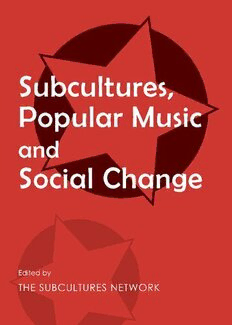Table Of ContentSubcultures, Popular Music and Social Change
Subcultures, Popular Music and Social Change
Edited by
The Subcultures Network
Subcultures, Popular Music and Social Change,
Edited by The Subcultures Network
This book first published 2014
Cambridge Scholars Publishing
12 Back Chapman Street, Newcastle upon Tyne, NE6 2XX, UK
British Library Cataloguing in Publication Data
A catalogue record for this book is available from the British Library
Copyright © 2014 by The Subcultures Network and contributors
All rights for this book reserved. No part of this book may be reproduced, stored in a retrieval system,
or transmitted, in any form or by any means, electronic, mechanical, photocopying, recording or
otherwise, without the prior permission of the copyright owner.
ISBN (10): 1-4438-5945-1, ISBN (13): 978-1-4438-5945-5
(cid:3)
CONTENTS
Acknowledgements ................................................................................... vii
Preface ........................................................................................................ ix
Caroline Coon
Contributors .............................................................................................. xiii
1. Subcultures, Popular Music and Social Change: Theories, Issues
and Debates ................................................................................................. 1
Bill Osgerby
I.THEORIZING SUBCULTURES AND POPULAR MUSIC
2. Subcultural Theory in France: A Missed Rendez-Vous? ....................... 49
Chris Warne
3. “It’s Where You Come From That Makes You Who You Are”:
Suburban Youth and Social Class.............................................................. 65
Andrew Branch
4. Youth Culture and the Internet: A Subcultural or Post-Subcultural
Phenomena? ............................................................................................... 89
Andy Bennett
II.THE CONSTRUCTION AND EXPRESSION OF SUBCULTURAL IDENTITIES
5. “A Harmonizing Whole”? Music, Mass Observation and the Interwar
Public House ............................................................................................ 105
Stella Moss
6. Neo-burlesque: Striptease, Subculture and Self-commodification ...... 121
Saphron Hastie
(cid:3)
(cid:3)
vi Contents
7. Ambitious Outsiders: Morrissey, Fandom and Iconography ............... 139
Lee Brooks
8. Subcultural Entrance Practices in UK Punk Culture, 1976–2001........ 155
Alastair Gordon
9. Staring at the Rudeboys: The Representation of Youth Subcultures
in Gautam Malkani’s Londonstani and John King’s Skinheads .............. 175
Nick Bentley
III.SUBCULTURES,GLOBAL FLOWS AND LOCAL CONTEXTS
10. The Stax/Volt Revue and Soul Music Fandom in 1960s Britain ....... 195
Joe Street
11. 1968 Underground: West German Radicals between Subculture
and Revolution.........................................................................................219
Timothy Scott Brown
12. “The Lad is Always Right”: Street Youth Groups in Russia
as Local Elites..........................................................................................235
Svetlana Stephenson
13. An Exploration of Deviance, Power and Resistance within
Contemporary Cuba: The Case of Cuban Underground Rap .................. 251
Eleni Dimou
Afterword ................................................................................................ 267
Dick Hebdige
Index ........................................................................................................ 295
(cid:3)
(cid:3)
ACKNOWLEDGEMENTS
Thanks to the contributors and all those who attended the inaugural
conference of the Interdisciplinary Network for the Study of Subcultures,
Popular Music and Social Change (London Metropolitan University,
2011). Thanks, too, to London Met’s Faculty of Social Sciences and
Humanities for supporting the original conference, and to both London
Met and the University of Sussex for supporting the production of this
book. Special thanks to Richard Barnes, Pauline Black, Caroline Coon,
Paul Gorman, Dick Hebdige and David Hesmondhalgh, to Jon Garland
and Paul Hodkinson for their support and editorial input, to Bernard G.
Mills and Nadine Fraczkowski for permission to reprint their photographs,
and to Dominic Shryane for his help in preparing the manuscript.
(cid:3)
(cid:3)
PREFACE
CAROLINE COON
When, in September 2011, Professor Malcolm Gillies, Vice Chancellor of
London Metropolitan University, opened the inaugural symposium of the
Subcultures Network, he drew attention to “the civil strife and riots” erupt-
ing into visibility all around us.
Immediately impinging on university life was the anger expressed by
young people against rising tuition fees, increased competition and cuts in
higher education. Farther afield was the Arab Spring. Over the symposium
weekend the Occupy Wall Street protest started, and would soon go world-
wide.
Extreme responses to economic desperation and political catastrophe
define decades and generations, and mark high crisis moments on the
wheel of revolution. We are witnessing another series of youth-led revolts
that promise, like all revolts of the past, to shake established status quos
and remedy the ills of the times.
As I sat among international delegates prepared to give papers at the
symposium there was a tangible sense of many being aware that the social,
economic and political history we could see being made before our eyes
from London to Athens and Los Angeles to Guangdong would soon be
subject to academic research and study.
A multiplicity of subcultures, scenes and tribes have always existed—
even in autocracies and military dictatorships—defined according to their
interaction with or rejection of prevailing zeitgeists. Usually it is the most
popular subcultures—most popular because they carry the most potent
political message against the status quo—that need and then create self-
service structures necessary for their welfare, communication, and plea-
sure. These self-service sites, magnets for the most acutely dysfunctional
and dispossessed, become the most obvious targets for attack and closure
by military or police forces disinhibited by characterizations of subcultural
youth as, at best, “dangerous”, “antisocial”, “mindless”, “feeble”, “amat-
eurish”, “disorganized”, “incoherent” and so on.
The steps young people take to defend themselves from the purposeful
trivializations, misunderstandings and dismissals of dominant culture are a
(cid:3)

